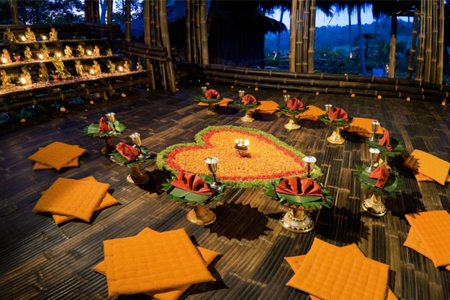
With spring upon us it is the perfect time to shake off the winter heaviness and recalibrate and invigorate our bodies. Our bodies naturally detox every day however with the large number of toxins we are exposed to daily through pollution, insecticides, alcohol, coffee, processed foods our bodies get overloaded.
The practice of cleansing is considered a vital part of an Ayurvedic lifestyle. It provides a means to clear accumulated waste and toxicity that can accumulate in the tissues compromising our health Panchakarma which is the Ayurveda cleansing and detoxing technique is often recommended.
The idea is that through the five actions of purgation, laxative therapy, herbal and oil enemas, the ama or toxins are driven back into the gastro track, and from there expelled from the body. It is a fairly strong and active treatment and and ideally should be done in a clinic where you can relax and focus your whole attention on the process.I t is not always necessary to go to this extreme, as you do need money and time, to take on a full Panchakarma.
There are less intense detoxes (including a milder form of Panchakarma) that can be recommended dependent on your lifestyle . I tend also to use a naturopathic detox that is high in protein and uses herbs and nutrients to support all three phases of detoxification.
Detox is particularly recommended in spring, because in the spring, your body’s natural cleansing and rejuvenating mechanisms kick into high gear, in tune with all of nature. Health is much more than an absence of a definable disease. Often we have forgotten what it feels like to be well and vital. A detox is a good start in the right direction. If you wish to discuss what detox could be right for you email me on perry@ayurvedahealth.co.nz. You will get added benefit if this is personalised to you.
Recipe – Kitchari
Ayurveda physicians often prescribe a kitchari diet before, during, and after panchakarma, to restore systemic balance. Kitchari provides nourishment while allowing the body to devote energy to healing. The grains provide the protein, the and spices kindle the digestive fire, that is often weakened by poor food combinations.
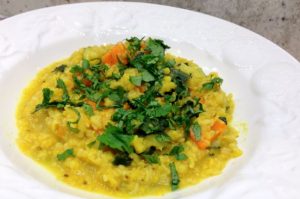
You can safely subsist on kitchari anytime in order to build vitality and strength as it helps balance all three doshas. For restless vata, the warm soup is grounding; for fiery pitta, its spices are calming; and for chilly kapha, it provides healing warmth.
1. First, rinse one cup of split yellow mung beans and soak for several hours. Set aside.
2. In a blender, liquefy one tablespoon of peeled, chopped ginger; two tablespoons of shredded coconut; and a handful of chopped cilantro with one-half cup of water.
3. In a large saucepan, lightly brown one-half teaspoon cinnamon; one-quarter teaspoon each of cardamom, pepper, clove powder, turmeric, salt; and three bay leaves (remove before serving) in three tablespoons of ghee, or butter.
4. Drain the mung dal and then stir it into the spice mixture, in the saucepan.
5. Next, add one cup of raw basmati rice. Stir in the blended spice and coconut mixture, followed by six cups of water.
6. Bring to a boil, cover, and cook on low heat for approximately 25 to 30 minutes until soft.
Mental Detox
I am using the natural inclination for “spring cleaning” to abide to that saying “less is more” trying to de clutter my life and home from all the excessive stuff that I seem to have accumulated. My husband is a minimalist when it comes to stuff, and has been a good influence on me reducing my need to consume (as was my habit). My wardrobe though still looks very abundant …
I like the saying that we should remove everything from our homes that cannot be used and that does not give us pleasure to look at.
That is my challenge for October. Do you want to join me?

Chyavanprash
Chyavanprash is an amazing formula that has been used for over 3000 years in Ayurveda to boost immunity, strengthen the body, providing energy and vitality. It is a type of herbal jam made from a base of amalaki fruit, a rich source of antioxidants.
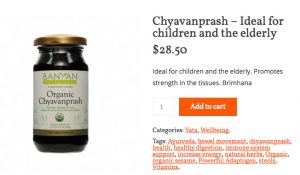
In one study, it was shown to increase the macrophage activity and their number, indicating enhancement of non-specific immune response and reduction of chances of infection.
Chyavanprash is an excellent method for daily herbal consumption due to its unique constituents of cane sugar, ghee and honey. These nourishing tastes play the important role of “carriers” that allow the herbs to penetrate deep into the tissues. Great for convalescence and respiratory conditions.
In a small daily dose (1 or 2 teaspoons), it makes for a tasty and very healthful treat. This tridoshic formula stimulates metabolism and enkindles the digestive fire without aggravating pitta. It balances vata and kapha while strengthening the body against the effects of a stressful lifestyle.
Upcoming Events

6-week course at the Yoga Tree Takapuna
Starting Wednesday October 19th – time 7 to 8 pm
Restorative yoga is a slower-paced form of yoga. It takes a healing, meditative approach and is a true antidote to our hectic pace of life. Give yourself the time to slow everything down for an hour– you will feel the benefits.
The benefits: increased focus, stress relief, better sleep, pain reduction, and more.
Book through The Yoga Tree – amanda@theyogatree.co.nz
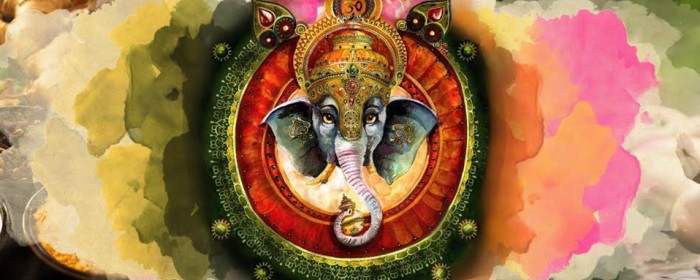
Ayurveda is an ancient medicine whose principles are tried and true. I am convinced that why Ayurveda works so well is that we really address lifestyle and diet – the basic building blocks of being well.
- EMF pollution and children’s vulnerability to this exposure
- Recipe of the month – spiced Lentil soup with coconut milk
- Wrap up of the Bali retreat – pictures say a thousand words
- Invite for Ayurveda Cooking classes where we look at how we can use our kitchen spices and foods as medicines.
One thing that was not around thousands of years ago, that in my opinion, needs to be addressed today is the issue of EMF – or Electric Magnetic Force. I have become more aware of this, as it can be measured through the hair profiling that Ayurveda Health offers, and it seems that young people in particular have particular high readings. The obsession with smart phones, laptops, desktop computers, home theatre systems, and all things electronic has made our lives easier in some ways, but much more complicated in others. This excessive uptake of EMF’s has contributed (especially to those who are sensitive) to poor sleep, anxiety and stress, decreased energy levels, gastrointestinal issues, thyroid disorders, and inflammation. EMF should be considered a harmful invader to your body, as it interferes with your health at a cellular level (after all we are all electrical beings). In yoga and Ayurveda we would see this has affecting the Prana (life-force) of the body.
What does happen at a cellular level? …..
Your cell membrane receptors recognize the electromagnetic fields at very low levels of exposure producing a stress respond – similar to when the body is exposed to toxic chemicals or heavy metals. This often referred to as ‘oxidative stress” – damaging DNA, which canbe the first step to cancer and contribute to conditions such as chronic fatigue syndrome, insomnia and fibromyalgia. Children are more affected than adults and this article makes an interesting read

What can we do?
1. Use it less and turn it off more. Even when your cell phone isn’t in use, it emits harmful radiation. Turn it off when not in use. And start using that landline again!
2. Keep it far away from your body. Don’t stow your cell phone in your pocket or your bra, or tuck it under your pillow at night. Keep it far away from your body so that you don’t expose yourself to unnecessary radiation.
3. Only use it when there’s good reception. The harder your cell phone has to work, the more radiation your body absorbs. Pay attention to those bars, and try to only use your cell phone in areas that get good reception.
4. Use a well-shielded wired headset. Not just any headset will do. If the wire isn’t well shielded, then it can transmit signals directly to the brain! Look for a well-shielded wire headset, particularly one with a combo shielded wire and air tube.
5. Have protection in your home. Plants in the home help, as do crystals and EMF protection devices. I am sure there are many more companies that provide, but I have used these products so feel OK about recommending them. Check out Life Energy Solutions – note they have a great offer at the moment a free radiasafe (protection from cell phone radiation) when you spend over $80.00 Click here to view now.
Recipe of the month – SPICED LENTIL SOUP WITH COCONUT MILK // Serves 6
This is a yummy warming soup for the colder months. The recipe calls for green lentil as split or red lentils will likely get too mushy here. I used 4 cups broth because I like my soups on the stewy side, if you prefer more broth to your soup, add another cup or two when cooking the lentils.
1 1/2 cup lentils, rinsed (green suggested)
4 cups vegetable broth
1 1/2 tsp. tumeric
1 tsp both cumin & coriander powders
1 – 2 Tbsp. coconut oil
1 large red onion, diced
2 stalks lemongrass, outer layer removed, lower portion finely minced
1 tsp. sea salt, plus more to taste
1/2 tsp. cardamom
1/2 tsp. cinnamon
pinch of red pepper flakes to taste
pinch of fresh grated nutmeg
1 1/4 cup coconut milk (use full fat, just believe me)
3 Tbsp. lemon, lime or orange juice a few handfuls of swiss chard, spinach or kale
1 /2 cup flake coconut, toasted (optional) chopped cilantro, for garnish (optional)
Add the rinsed lentils, broth, thyme and turmeric or curry powder to a large pot. Bring to a boil, turn down to a simmer and cook for about 20 minutes. While the lentils cook, heat the coconut oil in a pan. Add the onion and saute until just browned. Add the lemongrass, salt, cardamom, cinnamon, pinch of red pepper flakes and some fresh ground nutmeg and saute another minute. Add the onion mixture to the lentils and stir, keeping the heat on a low simmer.
Add the coconut milk and greens and simmer another five minutes, stirring occasionally until just wilted. Taste for salt andspice and add as you prefer. Finish with the citrus juice and serve warm with toasted coconut flakes and cilantro on top.
The Ayurveda and Yoga retreat 2016
No words are needed – the photos say it all. Thank you to all those who attended! Until next time…

Ayurveda education and cooking classes – This is more than a cooking class!
– How can we use our kitchen spices and food as medicine?
These classes are always popular but due to time restraints I have been unable to offer them until now. Lots of you have asked me, but to be honest I cant remember exactly who, so am offering “first in first served” as numbers are limited.
What you will learn
- Learn how to make food taste great and also be good for you
- Learn how to use food as our medicine
- Learn how to aide digestion to prevent bloating, gas, indigestion etc
- Learn the importance of utilising the various tastes in food to remain healthy
We will be cooking delicious, nutritious food.
The groups will be small (8 people max)
Dates and Times
Saturday 27th August 11.30m to 2.30pm
Thursday evening 31st August 6.30 to 9.30pm
The cost will be $120 per session.
Please confirm your place perrry@ayurvedahealth.co.nz

I like this saying… Often we work in a man’s world, trying to keep up with our male counterparts, forgetting that physiologically and psychologically we are very different species. Recently I went to a gathering at Lulu Lemon where I was invited to speak on Shakti – this is the female energy in the womb of every female – a women’s Shakti has the power to give life, create, nourish and nurture.
It made me think how as women we have really reduced our female power to the shadows.
What women need to entrust is their internal rhythms. There are certain times where we are more vulnerable, such as change of season, menarche and menopause, and during our moon cycle….. where our immune system can wan.
Hence we cannot always bring our “A” game – sometimes we need to retreat, slow down and reassess our priorities. Often I see women working hard out at the gym and opting for vigorous yoga practices when they are on their cycle. The old adage of taking time to rest and to care for themselves during their menses does not seem to occur.

Menstruation is an opportunity, not only for cleansing but also for rejuvenation. In Ayurveda your period can be understood as the body’s attempt to cleanse itself. Not jut the lining of your uterus but also all the toxins that have built up in your body. Menstrual difficulties are related to the amount of ama (toxins) in your system. Menstrual irregularities can be assisted by keeping the system clear and eating clean appropriate food for your body type.
If in any way or menstrual cycle is problematic you may find the following interesting…
Vata When out of balance the menstrual cycle can become irregular, or it can be unusually long. Blood flow may be light and the colour of the blood is often dark. Maybe be accompanied by feelings of anxiety, nervous tension and insomnia. Cramping, lower back pain, joint pain is also common. There may also be abdominal discomfort, bloating or constipation.
Pitta For women with a Pitta imbalance, there may be food cravings and increase appetite plus feelings of irritability and anger. Often the skin erupts and headaches, diarrhea, and hot flushes occur. Blood flow tends to be heavy and the colour of the blood is usually bright red.
Kapha With Kapha imbalance, the cycle is regular and is often accompanied by bloating and weight gain. Breasts can be swollen and tender. There is often a feeling of heaviness, achiness and stiffness in the joints and the back. Lethargy, oversleeping depression are common. Blood flow can be heavy and there may be clotting and excessive discharge.
Yoga Practice – Yoga practice Bottom line if your body gives signals that it wants to rest, listen, make adjustments, and modify your exercise and yoga regime. Gentle stretches may help, but in general not a strong yoga practice.
It is also recommended not to do abdominal exercises or inversions (like headstand or handstand) as these poses disrupt the normal flow and can result in more painful and heavy menstruation.
Shatavari – My favorite female herb
- Nourishing tonic for men and women
- Maintains a healthy female reproductive system
- Supports healthy lactation
- Promotes fertility and a healthy libido
Shatavari (Asparagus racemous) is a rejuvenative herb that strengthens and nourished the tissues. It is translated as “100 husbands” implying its role in promoting fertility and vitality used traditionally in maintaining healthy production of female hormones. It is one of those herbs that can be useful from menarche to menopause, supporting the reproductive organs and a healthy immune system. Is available in capsule or powder form.
Neti Pot – Once you have tried it you will be hooked. The first sign of a cold flush out your sinuses. The Neti pot is a powerful nasal irrigation system that alleviates congestion and sniffles, provides allergy relief, and clears the sinuses resulting in a clearer breath and interestingly a clearer mind. Saline solutions to unclog sinuses have been used for a while but the neti pot is more effective than saline nasal sprays.
To use fill the neti pot up with lukewarm pure water and add ¼ tsp of Himalayan salt. Tilt your head about a 45 – degree angle. Place the spout into your top nostril and tilt the pot so that the saline solution pours out the other nostril Switch and blow out in-between sides.
Detox Healthy Green Soup – warm, healthy and nourishing…. and delicious
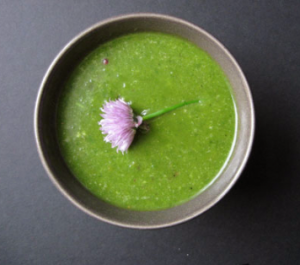
- 3 cloves garlic, minced
- 1/2 zucchini, sliced
- 1 small kumera
- 1– 1 ½ tsp. cumin
- 1 tsp. salt
- ½ tsp turmeric
- 2 cups of, chopped greens, such as kale, spinach, swiss chard, mustard greens, packed.
- 4 cups of vegetable broth
- ½ c. loosely packed cilantro
Directions –
- Heat a large stock pot over medium- low heat until hot and add the zucchini, sliced kumera, garlic and spices
- Add the greens gradually, you will have to add them 1 handful at a time, stirring and letting them cook down to add more. (Add spinach last as it takes the least amount of time to cook down)
- Add the cilantro and cover, bringing to a boil, then reduce the heat to simmer while covered and cook for about 20 minutes until greens are completely soft.
- Blend until smooth Adjust the seasonings if necessary, and return to simmer, 15 more minutes. Add a squeeze of lemon and then serve! Remove from the heat.
Bali Ayurveda and Yoga Retreat – July 2016
We are almost fully booked. This leaves one house – the Padi house – which seems really cute! Have a look click here to view.
This could sleep up to 4 people comfortably but is maybe best suited for a couple, Mother and daughter or close friends. There are a range of age groups, as well as beginners and more experienced yogis so everyone will be catered for. If you are interested in coming please contact me – Click here. It will be amazing!
Namaste Perry

The rhythm of the body, the melody of the mind, and the harmony of the soul create the symphony of life. – B.K.S. Iyengar
I am convinced that the more we connect and harmonise with ourselves and with Mother Nature the healthier we become. This means changing the ritual of our lives in accordance to the season, by adjusting our food and behavior.
Winter can aggravate conditions that can weaken your immune system—so it’s essential to take good care of yourself at this time of year. With that goal in mind, here are some suggestions to keep your immune system strong and your energy up. If the body is not getting what it needs it normally will ask for it? When the weather gets colder we naturally are attracted to warmer food to compensate for the colder weather but to take this concept further.
- Food Fuel – Eat warm, mushy foods- Soups, casseroles, curries, porridge are all on the menu. This means eat less raw and cold foods
- Lube it up – We need more fat in winter to counteract the dryness. Add more healthy oils to your diet – ghee, coconut oil, and flaxseed, avocado oils to your food.
- Spice it up – add more spice to your food – spices such as pepper, ginger, cinnamon, cayenne, cloves, cardamom, cayenne and turmeric to name a few. They all aid in digestion and are warming in property. An easy way to get more spice is to make the spice chai tea recipe below.
- Hydrate – Make sure you are drinking plenty of fresh, pure hot boiled water. Water is essential for the optimal function of every system in your body and hot water will help loosen mucus. Adding some raw ginger will enhance this action
- Oil your skin –an Ayurveda massage is deeply nourishing to your nervous system and stimulating for your lymph system. A monthly visit for an Ayurveda massage supported by daily application of medicated oils is one of the nicest things you can do for yourself.
- Sleep – we naturally want to sleep more in winter. Treat yourself to a few early nights a week. Before bed sip on warm milk with a small amount of nutmeg, ashwagandha, cinnamon and ghee for a sound and peaceful sleep.
Isn’t this interesting… Our amazing body is designed to preserve its own health. It is constantly replenishing its cells. Every second, several million red blood cells are removed and replaced from your circulatory system. Every five days, your stomach lining is renewed. Every thirty days, you have a brand new protective skin. Every ninety days, your body turns over all of the molecules that make up your bones.
Why then do we get sick?
Ayurveda puts a lot of emphasis on food, daily routine and honouring the seasons, in other words working with Mother Nature and her offerings. With the abundance and endless varieties of foods available from our supermarkets why is it impossible to feel nourished by what we buy? It is simple… Nature is not in command. Often our foods are sweetened, emulsified, stabilized, salted, irrigated, bleached, blanched, polished, degermed, sprayed, anti-spoiled…I could go on.
By the time some of the food reaches our tables it is loaded with more chemicals than a chemist shop. This is what we put into our precious bodies. We all know about good food choices, good lifestyle choices, exercise, sunlight, positivity and stress-coping techniques, – but it can be hard to remain focused and motivated, when you can’t see the effects of our choices in real-time. It seems that in many cases discomfort has to be severe enough to warrant change; and for many more, even that is not enough.
What we need to do – The Ayurveda perspective is to get away from the idea of quick fixes that are so firmly entrenched in our culture. Most healing takes time and commitment. It has to be truly felt. Once we become more aware we can make new choices, and let go of old habits that no longer serve us.
Having an Ayurveda Consultation is like having a road map – when you are out of balance you know what to do. This can be very empowering. Contact me to discuss various options for you and you’re well being. Click here.
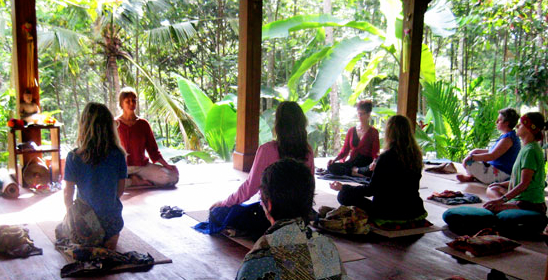
“The land where Gods come to rest”
Whether it’s your first or fifth time to Bali, this beautiful spot will be sure to capture your heart and soul, more so with a delicious daily practice of yoga and meditation, healthy food and great company.
Amanda Morrall, owner of The Yoga Tree, and Perry Macdonald, founder of Ayurveda Health, are delighted to be your hostesses on this special five-day retreat July 16-21 designed to add to life to your years and deepen your yoga, in all its forms. Read on to discover what’s on the agenda and what you can expect.
Bambu Indah – Ubud’s Eco Lifestyle Boutique Hotel
Pictures say 1,000 words so you get the idea I hope. This will be your home during the retreat. A 10 minute drive away from the hustle and bustle of Ubud, Bambu Indah is gorgeously situated, overlooking a rice field, perfect for enjoying breathtaking views during yoga, enjoying spectacular sunrises and sunsets and unwinding from city life in Auckland.
Our retreat will be a relaxing combination of yoga, health talks and tourism set in one of the most beautiful places in the world. Bambu Indah is an eco-friendly boutique created by Jonathan and Cynthia Harding, co-creators of the internationally renown Green School as well.
For only $300, Perry and Amanda will share their expertise on yoga, health and wellness and lead some optional outings including: the colourful spice market in Ubud, the Green School Village, sacred water temples and a day of massage. Details TBA.
Accommodation and airfare will be the responsibility of our guests however we have booked a block of houses available for our exclusive use along with the main Yoga Shala at Bambu Indah during our time together.
Our schedule
The retreat will officially start Saturday the evening of the 16th at 8 p.m., and will close Wednesday evening on the 20th.
Daily classes led by Perry and or Amanda will be held at 8.00 a.m. till 9.30 a.m.
Meditation (optional) will be held at 7 pm. nightly for one hour.
This may be include some light practise in a restorative style, Yoga Nidra or therapeutic yoga.
Perry will be leading several talks on Ayurveda so you can learn more about the sister science of yoga and how to find more balance in your daily life using this ancient knowledge.
Transportation
Travel to and from Bali will be left up to participants given the range of flight routes and prices etc. Flights are currently on sale for as low as $800 return if you don’t mind transiting through Australia and a few hours delay. Otherwise Air NZ flies direct. Virgin Airline has a moderately priced option, $1,300 return, with a two hour lay over in Brisbane. Earlier bookings will reduce the cost, so we recommend booking flights ASAP once you’ve confirmed your placement on this retreat.
Travel visas can be purchased at Denpassar airport upon arrival for a cost of $25USD.
The travel time from Denpassar Airport to Bambu Indah is approximately 2 hours depending on traffic. Bambu Indah charges $35 per car for the transport or you can organise your own from the airport. $30 USD is about the going rate but it’s easier to arrange this in advance as arrival as the airport arrival section can be confusing and crowded after a long flight.
Getting around Ubud
Bambu Indah is very comfortable so it’s tempting not to leave however there is plenty to do and take in around Ubud. Motorbikes hires are abundant (around $5 a day) and taxis service is competitive and cheap too. The retreat offers good quality motorbikes for $15 a day and can arrange taxis for you easily.
Beyond Ubud
Bali is a small Island but there is plenty to see. Our retreat will end Wednesday evening. Those of you who wish to stay on till Saturday can do so otherwise you are free to roam, and find your way around. The hotel staff are hugely helpful and Amanda is quite familiar with the terrain so can give you some suggestions on good places to go if you want to expand your horizons.
For a limited time, Bambu Indah is reserving use of the facility for The Yoga Tree.
All of the units are beautiful, some just bigger than others, different views, and art collections from the owners. Please have a look at the houses available to us and make your choice known to Diane Lion-Giustiniana at diane.manager@bambuindah.com.
Use “The Yoga Tree” as a reference.
Prices include a complimentary breakfast and afternoon tea. Dinners, snacks etc will be separate however there are a wide range of choices outside the resort so please ask.
Please check with Amanda or Perry for respective house prices if you can’t find them on the website. If you are sharing with a friend or spouse, the price remains the same and it is based on the house you hire. Most of the larger houses can accommodate an extra bed and are available upon request for an additional $35USD.
Cancellation and refunds etc are in accordance with Bambu Indah’s policy. See their website for details.
We are really excited about this event and look forward to working with you.
Amanda & Perry
Amanda 0275066550
Perry 021488054
Itinerary for Bali Retreat
So you can plan your days around the retreat, here is a brief outline of how the day will be structured and focused around our Retreat theme on the Elements (the Tattvas)
July 16 – 8.30 p.m – Welcome, orientation and blessing
We know you’ll all be a bit weary from the travel so this session won’t be any longer than an hour. The meditation on offer will be a perfect way to send you to a peaceful sleep.
July 17th –The Earth Element – stability and cohesion
8.00 am to 9.15am Yoga session – a grounding practice for flight recovery and connection to ourselves.
11.00 am Monkey Forest walk – through the famous Monkey Forest sanctuary. Feed the cheeky monkeys, get grounded after your flight and explore what’s around the area in Ubud central.
8.00 pm to 9.15 pm Discussion on how the 5 elements (tattvas) weave their way into Ayurveda. Followed by a restorative practice and meditation.
July 18 – The Water Element – our creative powers
8.00 am to 9.15 am Yoga session – finding flow in your practise
11.00 am Trip to Tirta Empul (Sacred water temple tour) *time subject to tourist office schedule.
8.00 pm – chat re importance of emotional health, how the chakras carry the blueprint of our creation. A gentle yoga practice and meditation will follow.
July 19 – The Fire Element – The power of transformation
8.00 am to 9.15am A practice that will honor the “fire” in our bellies.
11.00 am – Tour of the Ubud spice market led by Perry who will discuss the Ayurvedic concepts of digestive fire (agni) and how simple everyday spices influence our digestion.
8.00 pm to 9.15 pm Restore and meditate – Ayurveda chat – mind and body restore.
July 20 – The Air Element – all movement – Prana being the most pure.
8.00 am to 9.15 am Yoga session – Focusing on Pranayama – the importance of breathe
11.00 am Optional spa/shopping/Green School outings
8.00 pm to 9.15 pm Ayurveda chat – peaceful yin practice
July 21 – The Ether Element
8.00 am to 10.00 am Yoga session – sound as medicine – a little bit of chanting and mantra to go with our practice.
Free day to do as you please
12.00 pm closing lunch – Bambu Indah restaurant
Note – There is a probability this could change slightly but the suggested itinerary frames our intention for the 5 days. Everything suggested is optional.

At Ayurveda we take great interest in the tongue. We spend a lot of time looking at people’s tongues, which can say a lot about your present state of health, and can be a reflection of your internal organs and your level of toxicity. Every morning get up and scrap your tongue first thing to get the night slop off it. After that look again if it is pink you are doing great — If not it is sign that your system is overloaded.
This tongue coating is a sign of ama, which translates as toxins inside the digestive system. This coating, which is a mixture of bacteria, fungi and dead cells, can be clear, thick, white, yellow, brown or even greenish. We all have some coating, but the colour and amount is an important sign to your overall health. If you need more convincing, here are fi ve good reasons to
scrap your tongue daily.
• Eliminates bad breath — the cocktail of gunk on the tongue affects your breath. You will be more kissable for sure if you adopt this daily habit.
• Enhances the sense of taste — removing build up from the surface of the tongue will better expose your taste buds. Food tastes better
• Slows the growth of plaque and improves oral hygiene — leads to healthier teeth and gums assisting in tooth decay, gum infections, and gum recession. Your dentist will thank you.
• Improves digestion and immunity— the mouth is the first base of digestion. Swirling food around in a bacterial pool will not help in enhancing immune health. When coming down with a sore throat my suggestion is that we scrap the tongue more frequently so we can rid our mouths of unwanted toxins and give the body a chance to fight the infection.
• Gently stimulates the internal organs — your whole body is mapped on the tongue, just like your hands and feet (except, interestingly enough, not the reproductive organs). Scrapping your tongue stimulates and massages those corresponding organs as a form of acupressure.
WHAT THEN IS A TONGUE SCRAPPER AND HOW DO WE USE IT?
This is what it looks like, commonly made from copper or stainless steel. I tend to encourage copper due to its natural plaque and anti-bacterial actions.
This is what you do:
• Hold tongue scrapper firmly by both hands.
• Open your mouth and extend the tongue as far as possible.
• Using the fl at centre part of the scraper gently scrap from back to front using one long stroke.
• Rinse and repeat 5–6 times.
• Wash tongue scrapper well in hot water.
When you first get started be gentle, and don’t scrape if there are ulcers, open scars, or bumps on the tongue. You will be amazed how much stuff comes off your tongue in the morning and how great it feels to have a clean and fresh mouth.
Tongue Scrapper, for daily oral hygiene.
Click here to view and buy now.
Words: Perry Macdonald
(Dip Naturopathy – ND, Dip Ayurvedic Medicine)
Article by Verve Magazine
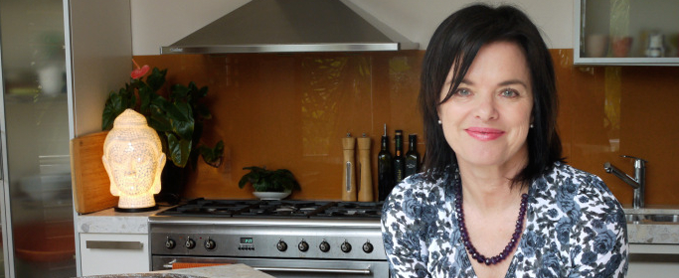
Over the past decade, Perry Macdonald has immersed herself in her passion for Ayurvedic medicine, a health system developed some five thousand years ago by the sages of India, and considered by many to be one of the world’s most enduring, sophisticated and powerful mind-body health systems. Perry loves what she does, and it is obvious that she practices what she preaches, as she radiates beauty, calmness, serenity and positivity.
Ayurveda
More than a mere system for treating illness, Ayurveda is a science of life (Ayur = life, Veda = science or knowledge). It offers a body of wisdom designed to help people stay vibrant and healthy while realising their full human potential. The two main guiding principles of Ayurveda are that the mind and the body are inextricably connected, and that we look at all dimensions of one’s being to see what could have made one vulnerable to getting sick in the first place. It offers countless practices for expanding self-awareness and cultivating an innate state of balance, for instance, through eating well; practicing meditation and getting the right amount of restful sleep.
According to Ayurveda, sleep is the nursemaid of humanity, so when a colleague mentioned feeling sluggish, possibly due to poor sleep patterns, it was suggested that she book a session with Perry.
Hair Test
Perry works from a tranquil studio with panoramic views across to the sea in Milford on the North Shore. After a friendly introduction, and a brief chat about what was bothering my colleague, Perry suggested commencing with hair profiling: a new technology that measures the resonance of the cells /or the epigenetics of the hair. It is more effective than conventional hair testing — prioritising nutritional needs (vitamins, minerals, fatty acids, anti oxidants, amino acids, EMF’s, toxins and more). You can find out a lot about your present state of health with results of the hair testing during that first session with Perry, who uses the results to assist with treatment advice.
Dosha
Hair test out of the way, Perry set about finding out more about my colleague and her poor sleep patterns. By working out what Dosha type she is, Perry will have a better insight into what might be causing the problem. The Doshas are the energies that make up every individual: there is Vata, Pitta and Kapha Dosha, and it soon becomes clear that my colleague may need to balance Pitta. Perry continues to ask questions, listens to the answers, frequently suggesting alternative and better ways of doing things, like having a routine around sleep, pen and paper by the bed to write down any bothersome and persistent thoughts, the removal of all technology from the bedroom, and making sure there is some sort of interlude between work and home. She strongly encourages a reflective practice and the use of oils/massage when showering or bathing.
HAIR PROFILING INTRODUCTORY OFFER $95.00
Contact Perry to make a booking.
Diet of course is all-important. A combination of muscle testing, and the results of the hair test emailed back to her from Germany all help to make recommendations. Then there is more chat about various herbs, metagenics supplements and Yoga Nidra — a deep relaxation and guided meditation technique.
The session is over for the day and my colleague walks away from this safe-haven with a plan that should help her release what is not working in her life, and restoration of better sleep patterns.
A month has elapsed since meeting Perry, and my colleague is looking more rested and calm, and says that the quality her of sleep continues to improve as she becomes more adept at doing the things recommended in her session with Ayurveda Health.
Perry’s Refreshing Ayurvedic Tea
A formula that revitalizes, helps to warm up circulation and clear out water retention. It stokes the metabolism (digestive fire) and will help purify the blood. An added bonus is that it tastes good.
Place the following ingredients into a tea infuser basket.
• 1/2 lemon diced
• 5cm fresh ginger sliced
• generous pinch of fennel seeds
• generous pinch of cardamom seeds
• generous pinch of coriander seeds
Pour over freshly boiled water and let stand for 5 minutes.
Verve Magazine November 2015
You’re cooking with massage oils?” a friend quips when I mention I’m off to an ayurvedic-cooking class. Clearly ayurveda is clearly best-known for things other than its cuisine. Native to India, the 5000-year-old tradition is, at heart, a self-care system of preventative medicine that meshes nutrition, meditation, massage, yoga, tailormade herbal remedies – and the odd tantra and mantra.
Practised by a string of celebs including Madonna, Gwyneth and Demi, ayurveda’s no longer just a lifestyle of the rich and famous. With its in-vogue aim of balancing mind and body, it’s become Miss Popularity in the Western world this millenium.
“Five years ago, no one could spell or say ayurveda, but they can now,” says Auckland ayurvedic practitioner Perry MacDonald. She has that radiant glow (but not in an irritatingly zen way) that most of us crave. Though she’s cagey about her age, it’s hard to believe she has two grown-up children.
Having turned her lifestyle into a career, Perry holds health consultations and retreats, teaches yoga and meditation, and practises massage through her company Ayurveda Health (www.ayurvedahealth.co.nz). She also runs an ayurvedic-cooking course – three classes held weekly – at her Milford home every couple of months.
As I’m doing the downward dog at her yoga class one Monday, MacDonald mentions her next round of classes, saying they’ll help people who struggle with adding taste to their food – especially vegetarian food.
This hits a nerve. Instead of emptying my mind on the mat, I’ve been pondering what to make for dinner. I’ve never had much of a cooking mojo. Vegetarian for 18 years, I’ve never learned how to cook tasty, healthy meat-free meals despite stacks of cookbooks and good intentions. The kindest adjective my partner can come up with for my stir-fries is “pedestrian”. I’d say soggy, tasteless, bland.
It turns out MacDonald runs the course for love, not money ($150 barely covers food costs), because she wants to spread the word about how to use spices, which add taste and aid digestion, in everyday cooking. Sold. A few weeks later I turn up in her kitchen, with its oven big enough to house Hansel and Gretel and its Buddha statue. I know ayurveda involves diagnosing doshas (physical constitutions/bioenergies), but you can take or leave that side of things.
Five others press the doorbell. Tim, a hairdresser with a booming laugh; his real-estate agent girlfriend Bernadette, whose lightning quips belie her corporate attire; wistful-looking hospice manager Janine; and mother-of-three Sue, whose daughter’s health problems spurred the family to cook differently. Then there’s project manager Mary, who has IBS, which Perry informs us can be cured by ayurvedic cooking. The jury’s out on that, but there’s consensus that spices (particularly hing and arjwan) aid digestion and reduce bloating.
Apart from the “place in bowel” directive, the recipes look pretty straightforward. Don’t be daunted, MacDonald tells us, by the long ingredient list: most are just a teaspoon of cumin here, a few arjwan seeds there. First up we’re making ghee, which looks much as you’d imagine: like a jar of lard, just yellower. The equivalent of olive oil to Italian cuisine, this clarified butter’s the building block of ayurvedic cooking. You simply heat unsalted butter until the milk sinks to the bottom and the water evaporates, leaving a rich, golden oil. “Ghee brings food alive,” MacDonald says. “A small amount goes a long way, and like whisky it gets better with age.”
We move on to two other ayurvedic-cooking bastions, vegetable subji and dahl, as Tim quips “Hey Dahl, what’s for dinner?” and Bernadette rolls her eyes. “If there’s nothing else in the house you can make subji,” MacDonald says, whipping out “something I prepared earlier”, Alison Holst-style. When I ask if it’s frozen veg, MacDonald shoots me a look of horror. She doesn’t do frozen – or leftovers – and shops fresh every day.
There’s a lot of stirring. Ayurvedic cooking is also about bringing awareness and mindfulness to your cooking and eating, says MacDonald, so you’re not just slapping it in the pot and shovelling it down while glued to The Bachelor. As she relays tidbits about each spice’s health-and-medicinal benefits, she reminds me of Ayla, the healer from the Clan of the Cave Bear book series – all she needs is a totem and medicine bag.
I haven’t looked forward to a meal this much in ages – and not just because aromas are wafting, it’s nearing 9pm and my stomach-gurgling has become alarming. Dinner, followed by spiced rice pud, is delicious. I chew slowly, relish the food, enjoy the company.
At class two, we make chutneys – one tomato, one cilantro-coconut – which go nicely with dahl or fish. And who knew my favourite takeaway – palaak paneer – could be so made easily and healthily? (Vegans can substitute tofu for cheese.) Dessert, semolina halva, is substantial enough to double as breakfast.
At the last lesson, Sue informs us that, to her shock, her three fussy-eater kids liked her paneer. There’s another surprise in store. We’re expecting to make another subji or curry, so we’re thrown when MacDonald, who’s trying to break down the myth that ayurvedic cooking is always Indian, announces tonight’s main is ayurvedic fish ‘n’ chips.
Baked fish is coated in a spicy paste that’s also good for meat and tofu; served with wilted veges, crispy potatoes, and cilantro-coconut chutney; followed by spicy fruit crumble and washed down with a little chai. Because I eat slowly, appreciating each bite, I don’t leave the table over-full, but MacDonald insists we leave her with the dishes. She even makes us up a basic spice tin for me.
After stocking up on every imaginable spice from Mahadeo’s and buying the requisite mortar and pestle, I try flying solo. I can now turn out a decent dahl, vegetable subji, even palaak paneer. It doesn’t taste like MacDonald’s cooking – yet – but it’s good. And as those mustard seeds pop, for the first time in years I’m having fun in the kitchen.
Mung Dahl
1 cup of split Mung Dahl
3-4 cups of water
1 tsp mustard seeds
1 tsp cumin seeds
4 Tbs ghee
1 pinch of hing (Indian spice, also known as asafoetida)
2 clove of garlic
2 tsp grated ginger
10-12 curry leaves
1/2 tsp turmeric
1 tsp coriander powder
2 tsp cumin powder
1/2 tsp chilli powder (optional)
Salt to taste
Handful of chopped coriander leaves
Lime juice to taste
Rinse the lentils until water runs clear. Mung dahl needs no pre-soaking. Cook dahl on medium heat and skim off any foam that builds at the top.
Add cumin, coriander, turmeric, salt, ginger, chilli, to the dahl. Continue boiling on low heat .
Seasoning
Heat ghee in a small saucepan.
Add mustard seeds and once they have popped add cumin seeds, a pinch of hing, chopped garlic and curry leaves and fry for a few seconds.
Add the seasoning to the boiling dahl.
Boil for a further 3-4 minutes, then garnish with chopped coriander leaves.
Add a dash of lime and serve hot with steamed rice or roti.
– NZ Herald
For organic hair colour that is a great experience and also economical www.hue.co.nz
My favourite Yoga schools www.yogasanctaury.co.nz and www.northshoreyoga.co.nz
An excellent site to find Ayurvedic recipes www.joyfulbelly.com
A good friend and colleague who built this website, also practising Ayurveda www.ayurvedawellbeing.co.nz
Home delivered organic Vegetables that are not too pricey www.naturallyorganic.co.nz
I have been practicing meditation for a long time and now teach it. My belief in meditation, as importantt to health and well-being continues to grow. I have noticed how as I continue to practice there is a deepening in all my experiences.The inner silence and sense of peacefulness is carried forth more and more into my daily activity.
I am sure I used to be very black and white with strong opinions. I know sense that I can come from a place, where I know but I don’t know, so my mind is more open and receptive to receive.
The simple act of consciously inhaling and exhaling (breathe meditation) grounds us in our bodies, reminding us where we are, who we are and how precious our life is. When we connect deeply to our own existence in this way many of the petty thoughts and feelings that can dominate our minds dissolve without any effort
If you wish to attend a restorative yoga class where we prepare our bodies and minds, so we can settle into a lead meditative practice you would be very welcome.
perry@ayurvedahealth.co .nz
I like this saying – Women are not small men. Often we work in a man’s world, trying to keep up with our male counterparts, forgetting that physiologically and physcologically we are very different species. Often I see young girls working hard out at the gym and opting for vigorous yoga practices when they are on their cycle. The old adage of taking time to rest and to care for themselves during their menses does not seem to occur. Menstruation is an opportunity not only for cleansing but also for rejuvenation. With each monthly cycle, enormous hormonal shifts occur. In Ayurveda your period can be understood as the body’s attempt to clean itself out. Not jut the lining of your uterus but also all the toxins that have built up in your body. Menstrual difficulties are related to the amount of ama (toxins) in your system. Menstrual irregularities can be avoided by keeping the system clear and eating clean appropriate food for your body type.














